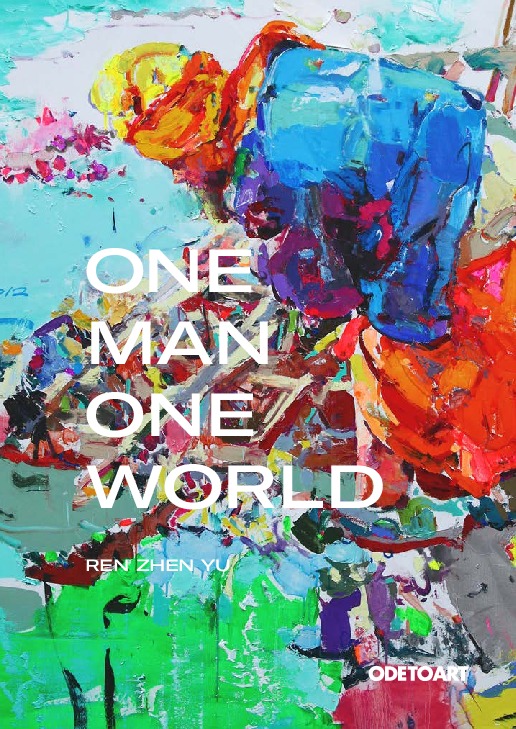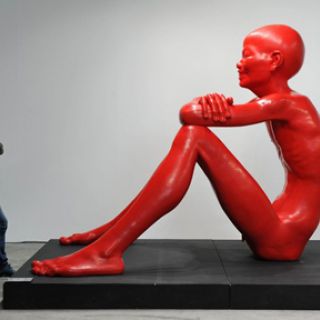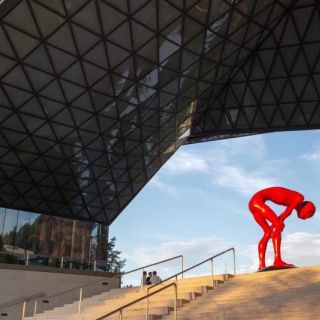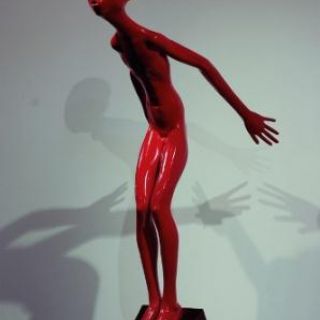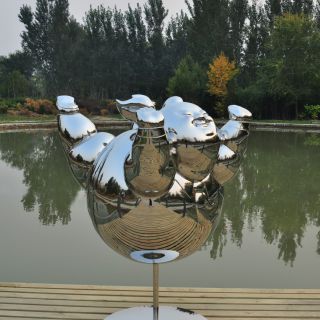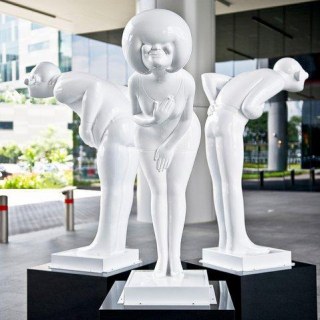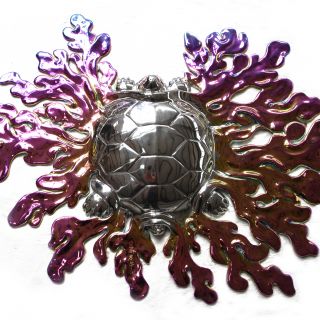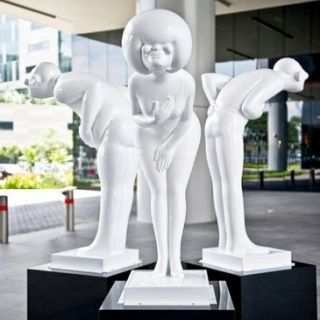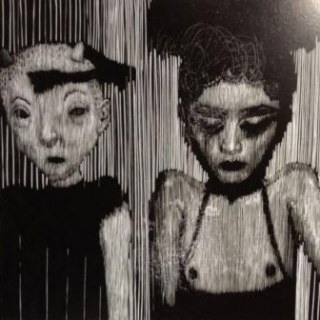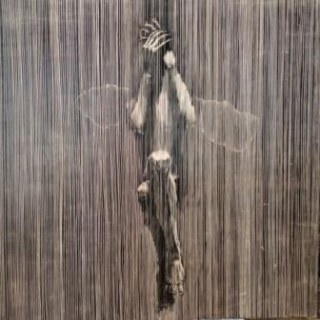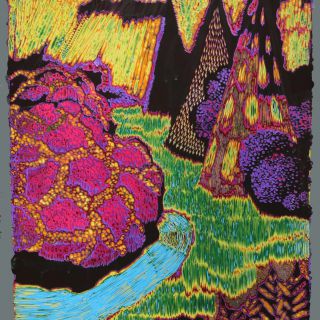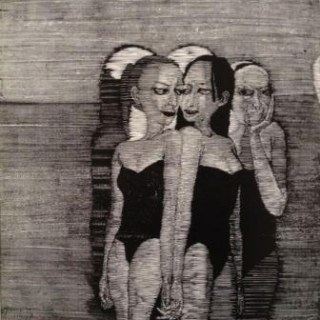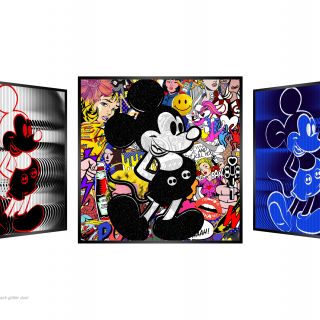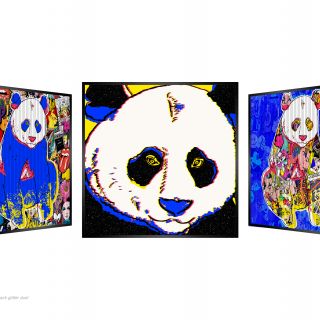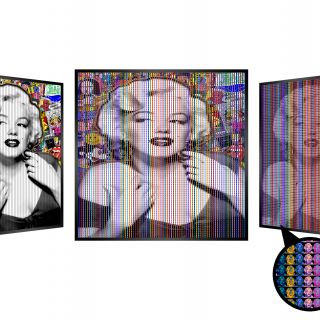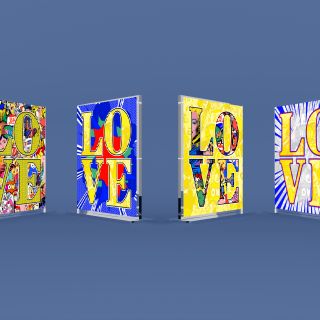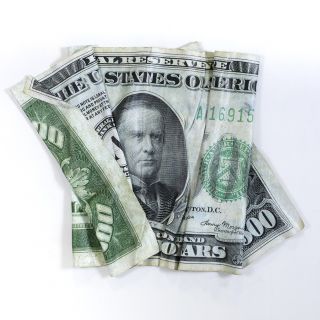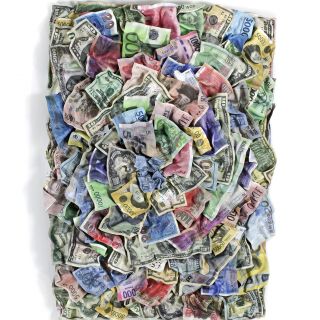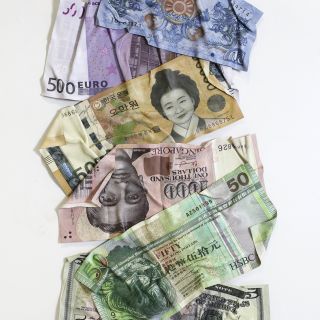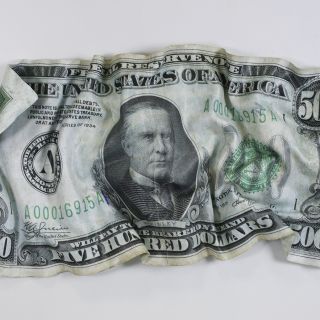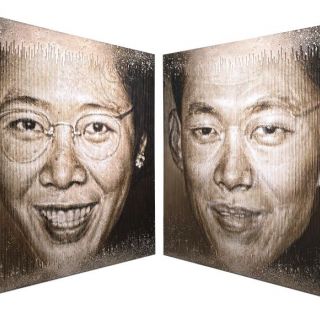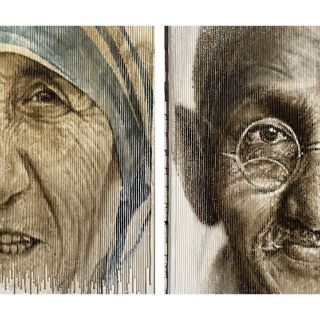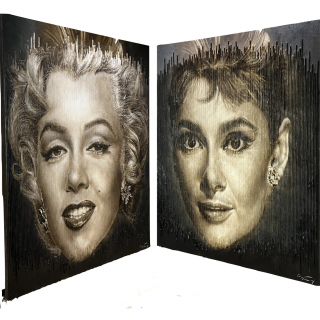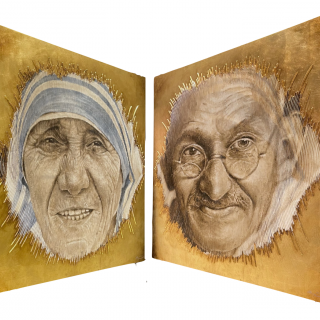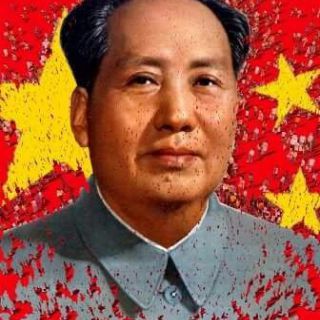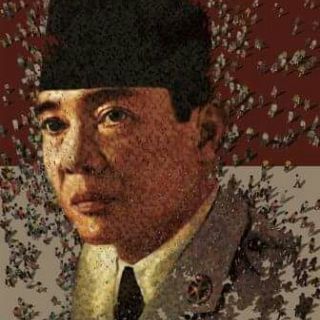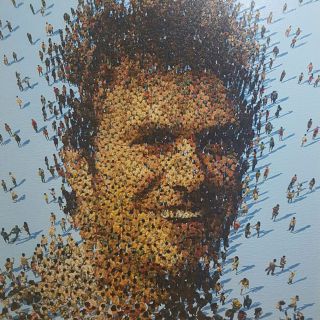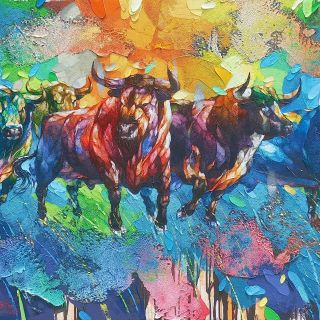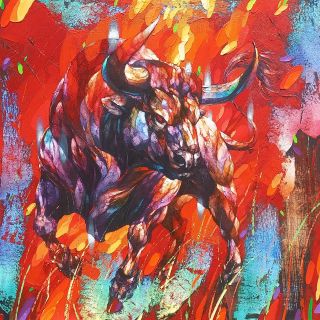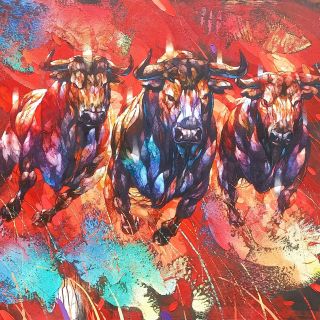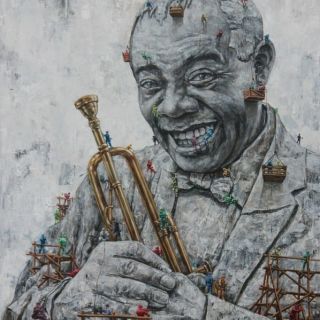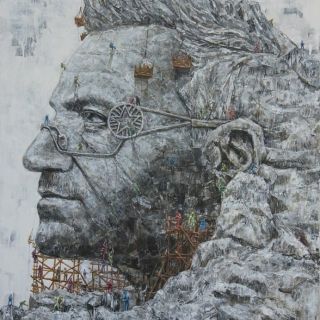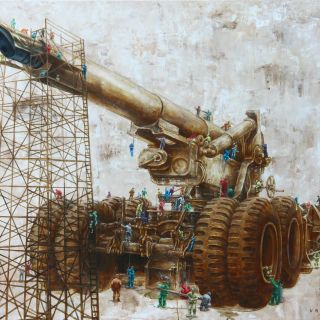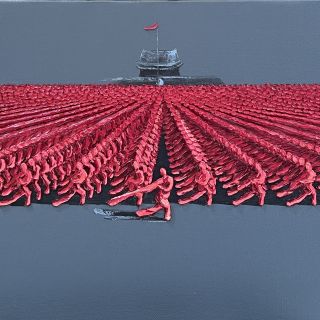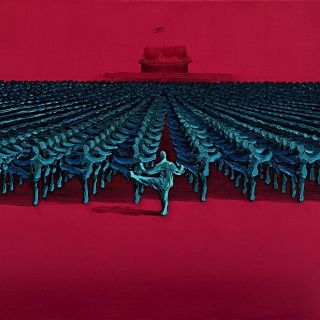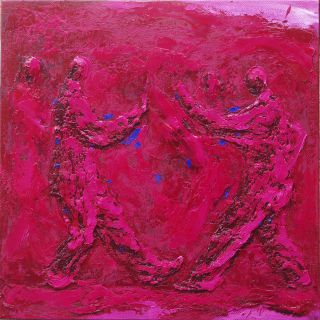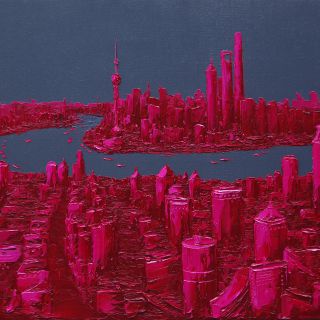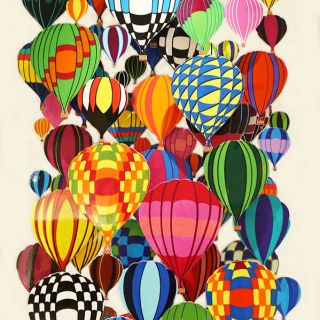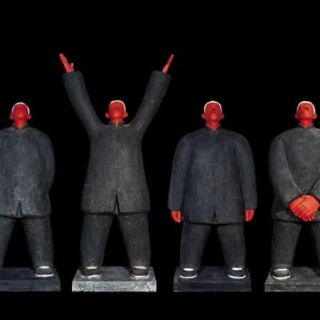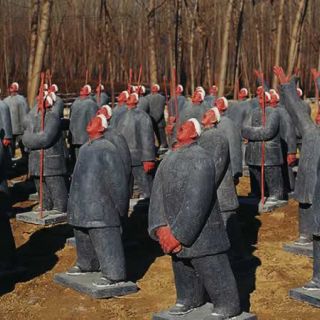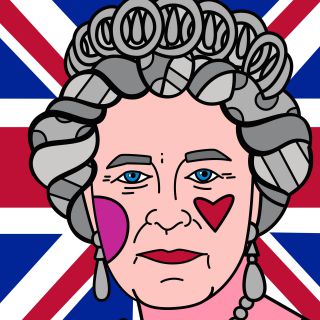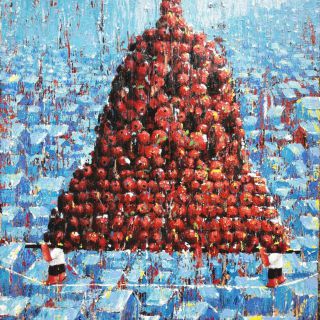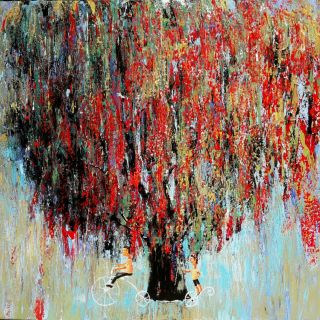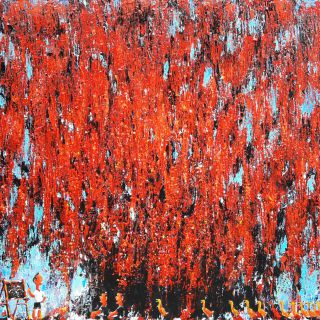
Born in Tianjin in 1976, Ren Zhenyu graduated in 1999 from the Oil Painting Department at Tianjin Academy of Fine Art, where he currently works as a lecturer. His talent was recognized and appreciated by renowned galleries and distinguished collectors throughout China, and he achieved fame in Europe through his distinct portrait series of historical and political icons, such as Andy Warhol and Chairman Mao. In his works, Ren plays with a wide spectrum of colours that are juxtaposed to create a unique expressionist interpretation of famous faces and experiments with texture and layering built on to reinforce the portrayal of faces from different perspectives.
Videos 
Videos
Biography 
Biography
Born in Tianjin in 1976, Ren Zhenyu graduated in 1999 from the Oil Painting Department at Tianjin Academy of Fine Art, where he currently works as a lecturer. His great talent has been recognized and appreciated by renowned galleries and distinguished collectors throughout China, and increasingly worldwide. His work has been represented in several exhibitions in China and is spreading globally. He has achieved fame in Europe through his distinct portrait series of historical and political icons such as Andy Warhol and Chairman Mao.
In his works, Ren plays with a wide spectrum of colours that are juxtaposed to create a unique expressionist interpretation of famous faces and experiments with texture built on layering to reinforce the portrayal of faces from different perspectives. He adopts a manner closer to Pop Art than to the currently dominant Chinese Neo-Realist style. Ren infuses contemporary perspective together with the history and memories attached to these historic icons, making their reminiscing evergreen.
Ren subtly controls the interaction between brightness and colour to present the diversity of the icons he chooses to represents. This diversity creates questions of whether Ren intends to depict these icons in their media-portrayed image as the masses recognise them, or to create a new representation through abstract expressionism.
These multi-coloured and variegated portraits by Ren were created over years of artistic observation. The technique is completely different from many artists who have previously painted these iconic images. The artist wanted his work to be loose and soft, and as a result the vague face appeared in new forms.
In his works, Ren Zhenyu uses his tones to manifest the eroding power of time. Art becomes not only a secret position of time and history, but also a reflection of the artist's interests and feelings. Ren's works present the conflict of remembrance. His works present the recording of images in a striking form and also provide the spiritual signs to our eventual art history.
Awards
2007: "Gathering Sandcastle - 2007 New Elite Award" Beijing
1998: Awarding of "7th National Oil Painting Scholarship"
Ren subtly controls the interaction between brightness and colour to present the diversity of the icons he chooses to represents. This diversity creates questions of whether Ren intends to depict these icons in their media-portrayed image as the masses recognise them, or to create a new representation through abstract expressionism.
These multi-coloured and variegated portraits by Ren were created over years of artistic observation. The technique is completely different from many artists who have previously painted these iconic images. The artist wanted his work to be loose and soft, and as a result the vague face appeared in new forms.
In his works, Ren Zhenyu uses his tones to manifest the eroding power of time. Art becomes not only a secret position of time and history, but also a reflection of the artist's interests and feelings. Ren's works present the conflict of remembrance. His works present the recording of images in a striking form and also provide the spiritual signs to our eventual art history.
Awards
2007: "Gathering Sandcastle - 2007 New Elite Award" Beijing
1998: Awarding of "7th National Oil Painting Scholarship"
Exhibitions 
Exhibitions
2017
One Man, One World, Ode To Art, Singapore
2016
You Are My Imagination, Art Futures Gallery, Hong Kong
2011
EGG Gallery, SH Contemporary 2011, Shanghai Exhibition Center, China
2010
The Marks: Contemporary Artists, Times Art Museum, Beijing, China
2009
"Icon", London, England
“Visible And Invisible”, Galerie Frank Schlag, Essen, Germany (solo exhibition)
FRIEZE ART FAIR,London,UK
2008
"Wind Flowing", Joyce Gallery, Hong Kong
"New Pop Face", Gallery Beijing Space, Beijing, China
"Another Portrait", Willem Kerseboom Gallery, Amsterdam, The Netherlands
Willem Kerseboom Gallery, SCOPE Basel, Switzerland
2007
"Looks Just Beautiful", Ode To Art Gallery, Singapore
"Looks Just Beautiful", Joyce Gallery, Hong Kong
2005
"In The Name of Face", Gallery Beijing Space, Beijing, China
Guangzhou Modern Art Fair, Guangzhou
2003
The 3rd National Oil Painting Exhibition, Beijing
2002
"New Changes" - Young Artist Nomination, Tianjin Exhibition of Elite Graduates from Mainland China, National Dr. Sun
1999
The 9th National Fine Art Exhibition, Shanghai Art Museum, Shanghai
One Man, One World, Ode To Art, Singapore
2016
You Are My Imagination, Art Futures Gallery, Hong Kong
2011
EGG Gallery, SH Contemporary 2011, Shanghai Exhibition Center, China
2010
The Marks: Contemporary Artists, Times Art Museum, Beijing, China
2009
"Icon", London, England
“Visible And Invisible”, Galerie Frank Schlag, Essen, Germany (solo exhibition)
FRIEZE ART FAIR,London,UK
2008
"Wind Flowing", Joyce Gallery, Hong Kong
"New Pop Face", Gallery Beijing Space, Beijing, China
"Another Portrait", Willem Kerseboom Gallery, Amsterdam, The Netherlands
Willem Kerseboom Gallery, SCOPE Basel, Switzerland
2007
"Looks Just Beautiful", Ode To Art Gallery, Singapore
"Looks Just Beautiful", Joyce Gallery, Hong Kong
2005
"In The Name of Face", Gallery Beijing Space, Beijing, China
Guangzhou Modern Art Fair, Guangzhou
2003
The 3rd National Oil Painting Exhibition, Beijing
2002
"New Changes" - Young Artist Nomination, Tianjin Exhibition of Elite Graduates from Mainland China, National Dr. Sun
1999
The 9th National Fine Art Exhibition, Shanghai Art Museum, Shanghai
Critique 
Critique
The Memorial Light And Image Brightness: Mao's Face By Ren Zhenyu
It's unquestionable that the representation of Mao's image in China's contemporary art is a splendid but complex phenomena. Contemporary Chinese art can be said to revolve around the person of Mao. The strength of a single image is affirmed by memories of the past - the ambiguity, though, lies in the question of whether the repeating of Mao's image is an attempt at healing those memories, or a recollection by means of Saint Art.
As Ben Yaming said, in times of technical reproduction, there still remains brilliant artistic expressions of head portraits and face images in the last century. Lu Xun and Mao Zedong's images seem to have the power of stateliness and permanence. The responsibility to the face and more importantly, responsibility to memories is now the obligation of the artist. Mao's head portraits take the salient role of embodying that which is necessary for us to face their modern impact. Our nation's thinking and spirit never breaks away from the wizardry of his image - the image that not only can face the calamity of the past, but also the changes of the future. The artistic creation of Mao's images fill the void of spiritual desolation of our times where we still need a former deity; an instrument to resist the panic and uneasiness of the present. Whether to laugh or to accord respect, it is a remedy for the emptiness of our heart, for a while.
Mao's face created by Ren Zhenyu represents Mao in his brilliance. In his last decades, he was a source of inspiration, of countless songs and posters which depicted him as a symbol of brightness, a symbol which lingers in our times for many people. Ren Zhenyu subtly controls the interaction between brightness and colour to present the diversity of Mao's look. This diversity creates questions of whether Ren intends to depict Mao in his real image of The Chairman Mao of the past or to create a new representation with abstract expressionism - to rebuild the past as a means of a salvation. We are left to wonder if the artist wants us to believe that his splendid and young Mao should be preserved in our memory.
These multi-coloured and variegated Mao faces by Ren Zhenyu were created after years of art observation. The technique is completely different from many artists who have previously painted Mao images. In the 'Soft Tissue' series of 2002, the artist had already subtly hidden the face with abstract color-blocking for the eyes, lips and facial features revealed in tones of black, white and gray which were meant to imply the faces were concealed in memory. The artist wanted his work to be loose and soft, and as a result the vague face appeared in new forms. In his works, Ren Zhenyu uses his tones to manifest the eroding power of time. His recent Mao's face has a sharp-cut style: apparently those "Soft Tissue" became tough, the previous subtle face breaks through the historical fence, springing out to be real. Is this a compelling reminiscence or the seductive brightness? Art becomes not only a secret position of time and history, but also a reflection of the artist's interests and feelings.
In his recent works, Mao's faces are depicted as the still well-known standard images throughout his various ages. The rich and bright colour blocks establish a lively look, as if the image never dies and lives with us, like a ghost looking at us with arrogant expression. Perhaps it is the reverence from young artist? The face which is painted with abstract color blocking seems never to be senescent as though life needs to preserve its illusion; where the leader needs his ideal image to be kept and almost suggesting that we can't escape from these transitory times. He presents the unique face of Mao. It's not ironic, but recalls a politician's destiny with images full of meaning and eidolon.
The artist creates his interpretation of time, which is a sign of spirit. In fact, sometimes the artist puts lattice work on the ground, to make concrete the transient image. Sometimes, two Mao's faces appear in a painting with gunfire - obviously he clears up the fears through a playful heart. Accordingly, it shows that the artist includes personal sentiment in his paintings.
Any portrayal of Mao's face would meet with either rejection or reverence, but more importantly, it creates an impact - we have to face the image eventually. Ren Zhenyu's works present the conflict of remembrance. His works render the recording of images in a striking manner.
Ren Zhenyu's interpretation of other emblematic figures of the last 50 years include Albert Einstein, Winston Churchill, Queen Elizabeth II, Diana, Princess of Wales, Barack Obama, Francis Bacon, Lucian Freud, Deng Xiaoping, Lee Kwan Yew, Damian Hirst etc. Through his bold,mesmerizing portraits, Ren investigates the concept and nature of the term 'icon', raising questions about what makes a figure iconic and how that perception is perpetuated. In Ren's portrait of Deng Xiaoping, leader of the Communist Party of China, Deng was a reformer who led China towards a market economy. Deng became the core of the "second generation" of Chinese leadership. He is considered "the architect" of a new brand of socialist thinking. Deng opened China to foreign investment, the global market, and limited private competition. He was generally credited with developing China into one of the fastest growing economies in the world for over 30 years and raising the standard of living of hundreds of millions of Chinese.
Xia Kejun
It's unquestionable that the representation of Mao's image in China's contemporary art is a splendid but complex phenomena. Contemporary Chinese art can be said to revolve around the person of Mao. The strength of a single image is affirmed by memories of the past - the ambiguity, though, lies in the question of whether the repeating of Mao's image is an attempt at healing those memories, or a recollection by means of Saint Art.
As Ben Yaming said, in times of technical reproduction, there still remains brilliant artistic expressions of head portraits and face images in the last century. Lu Xun and Mao Zedong's images seem to have the power of stateliness and permanence. The responsibility to the face and more importantly, responsibility to memories is now the obligation of the artist. Mao's head portraits take the salient role of embodying that which is necessary for us to face their modern impact. Our nation's thinking and spirit never breaks away from the wizardry of his image - the image that not only can face the calamity of the past, but also the changes of the future. The artistic creation of Mao's images fill the void of spiritual desolation of our times where we still need a former deity; an instrument to resist the panic and uneasiness of the present. Whether to laugh or to accord respect, it is a remedy for the emptiness of our heart, for a while.
Mao's face created by Ren Zhenyu represents Mao in his brilliance. In his last decades, he was a source of inspiration, of countless songs and posters which depicted him as a symbol of brightness, a symbol which lingers in our times for many people. Ren Zhenyu subtly controls the interaction between brightness and colour to present the diversity of Mao's look. This diversity creates questions of whether Ren intends to depict Mao in his real image of The Chairman Mao of the past or to create a new representation with abstract expressionism - to rebuild the past as a means of a salvation. We are left to wonder if the artist wants us to believe that his splendid and young Mao should be preserved in our memory.
These multi-coloured and variegated Mao faces by Ren Zhenyu were created after years of art observation. The technique is completely different from many artists who have previously painted Mao images. In the 'Soft Tissue' series of 2002, the artist had already subtly hidden the face with abstract color-blocking for the eyes, lips and facial features revealed in tones of black, white and gray which were meant to imply the faces were concealed in memory. The artist wanted his work to be loose and soft, and as a result the vague face appeared in new forms. In his works, Ren Zhenyu uses his tones to manifest the eroding power of time. His recent Mao's face has a sharp-cut style: apparently those "Soft Tissue" became tough, the previous subtle face breaks through the historical fence, springing out to be real. Is this a compelling reminiscence or the seductive brightness? Art becomes not only a secret position of time and history, but also a reflection of the artist's interests and feelings.
In his recent works, Mao's faces are depicted as the still well-known standard images throughout his various ages. The rich and bright colour blocks establish a lively look, as if the image never dies and lives with us, like a ghost looking at us with arrogant expression. Perhaps it is the reverence from young artist? The face which is painted with abstract color blocking seems never to be senescent as though life needs to preserve its illusion; where the leader needs his ideal image to be kept and almost suggesting that we can't escape from these transitory times. He presents the unique face of Mao. It's not ironic, but recalls a politician's destiny with images full of meaning and eidolon.
The artist creates his interpretation of time, which is a sign of spirit. In fact, sometimes the artist puts lattice work on the ground, to make concrete the transient image. Sometimes, two Mao's faces appear in a painting with gunfire - obviously he clears up the fears through a playful heart. Accordingly, it shows that the artist includes personal sentiment in his paintings.
Any portrayal of Mao's face would meet with either rejection or reverence, but more importantly, it creates an impact - we have to face the image eventually. Ren Zhenyu's works present the conflict of remembrance. His works render the recording of images in a striking manner.
Ren Zhenyu's interpretation of other emblematic figures of the last 50 years include Albert Einstein, Winston Churchill, Queen Elizabeth II, Diana, Princess of Wales, Barack Obama, Francis Bacon, Lucian Freud, Deng Xiaoping, Lee Kwan Yew, Damian Hirst etc. Through his bold,mesmerizing portraits, Ren investigates the concept and nature of the term 'icon', raising questions about what makes a figure iconic and how that perception is perpetuated. In Ren's portrait of Deng Xiaoping, leader of the Communist Party of China, Deng was a reformer who led China towards a market economy. Deng became the core of the "second generation" of Chinese leadership. He is considered "the architect" of a new brand of socialist thinking. Deng opened China to foreign investment, the global market, and limited private competition. He was generally credited with developing China into one of the fastest growing economies in the world for over 30 years and raising the standard of living of hundreds of millions of Chinese.
Xia Kejun

Stay connected.
Sign up to our newsletter for updates on new arrivals and exhibitions




